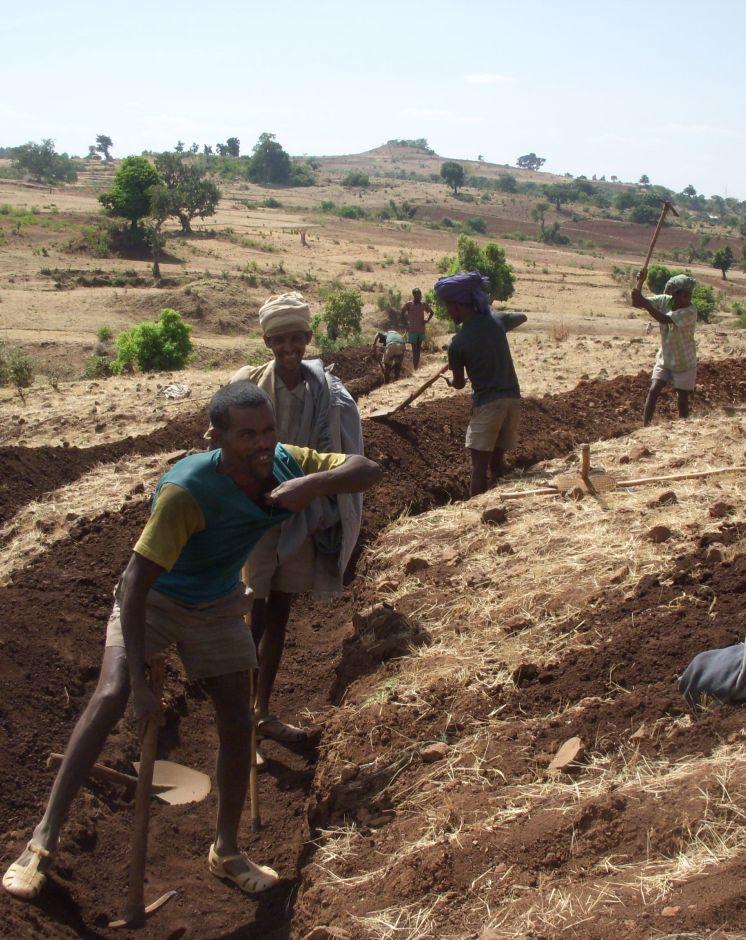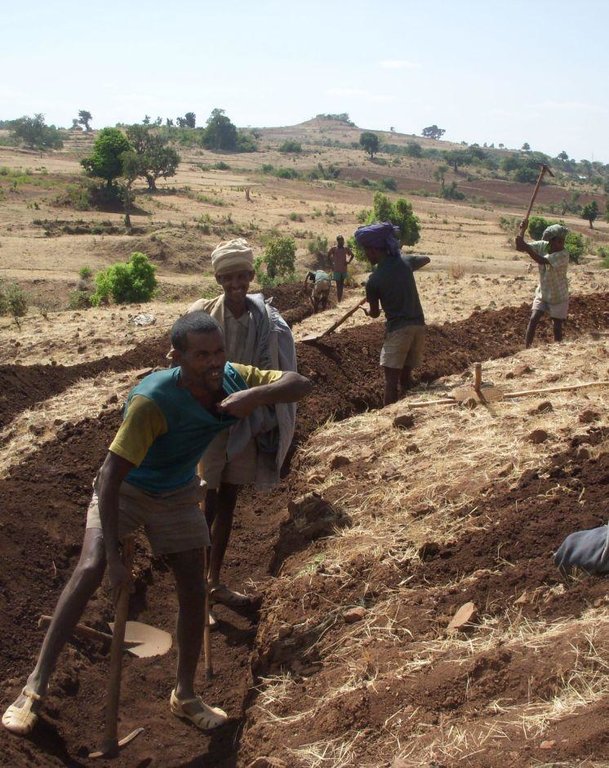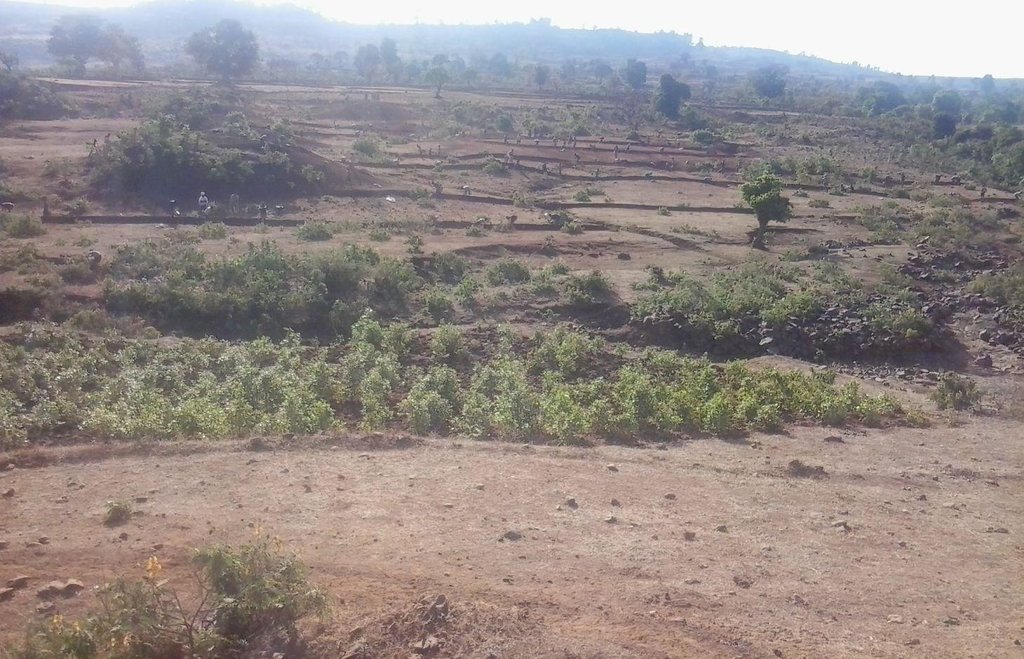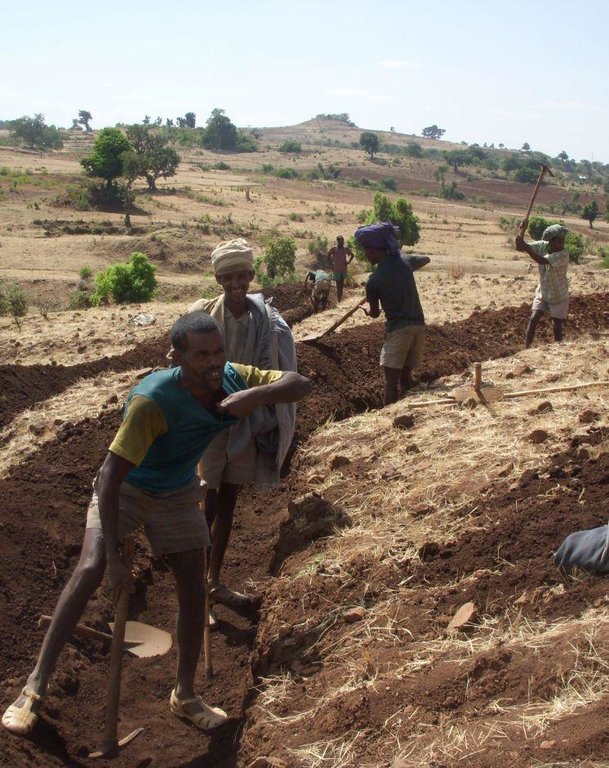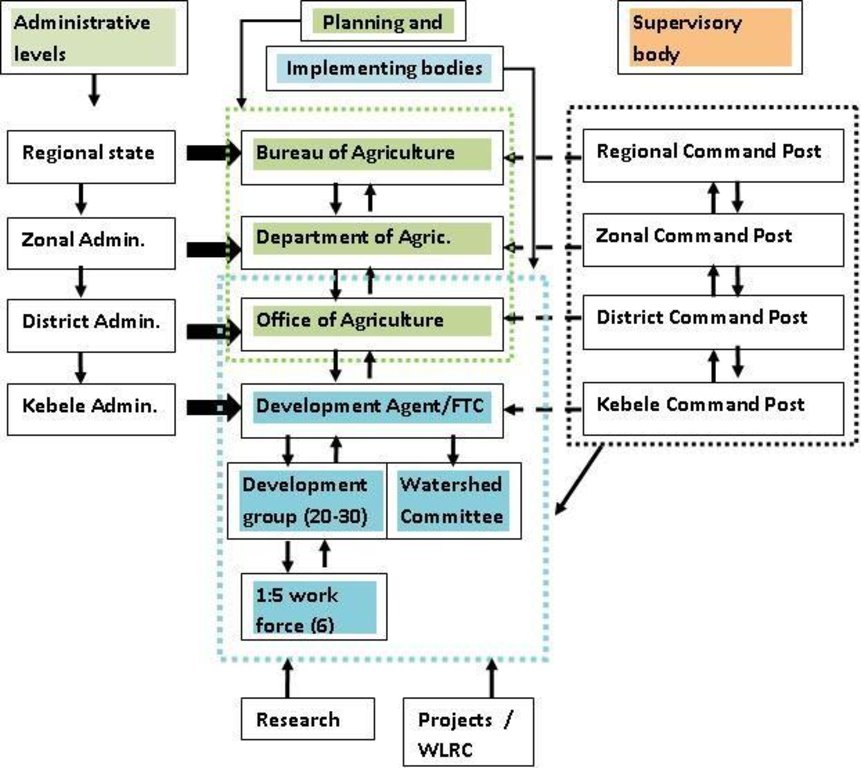Community Organizations and Mobilization for Soil and Water Conservation Work (COM-SWC) [埃塞俄比亚]
- 创建:
- 更新:
- 编制者: Gizaw Desta Gessesse
- 编辑者: –
- 审查者: Fabian Ottiger
Mass Mobilization (English) or aferna wuha tibeka zemecha (Amharic)
approaches_2495 - 埃塞俄比亚
查看章节
全部展开 全部收起1. 一般信息
1.2 参与方法评估和文件编制的资源人员和机构的联系方式
SLM专业人员:
Melese Bekure
WLRC
埃塞俄比亚
SLM专业人员:
Endashaw Aytenew
aytenewendeshaw@yahoo.com'
BoA/Amhara
埃塞俄比亚
有助于对方法进行记录/评估的机构名称(如相关)
Water and Land Resource Centre (WLRC) - 埃塞俄比亚有助于对方法进行记录/评估的机构名称(如相关)
BoA - Amhara national regional state agriculutral bureau (BoA/Amhara) - 埃塞俄比亚1.3 关于使用通过WOCAT记录的数据的条件
编制者和关键资源人员接受有关使用通过WOCAT记录数据的条件。:
是
1.4 SLM技术问卷的参考
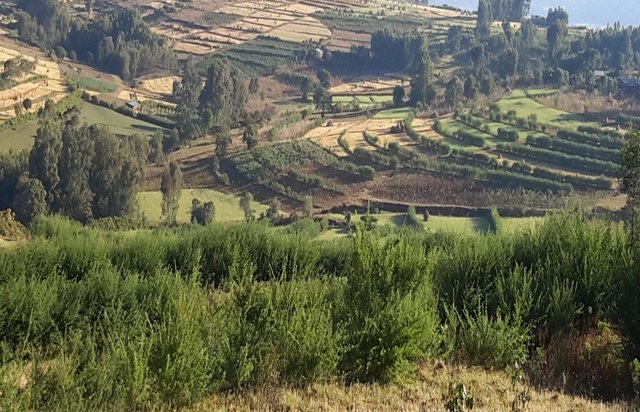
Vegetated graded soil bund [埃塞俄比亚]
Vegetated graded soil bund is a soil conservation practice meant for cultivated lands and constructed by excavating graded channel on upper side and develop embankment on lower side which is planted with grass or shrub species in order to control soil erosion and drain excess runoff implemented through community mobilization.
- 编制者: Gizaw Desta Gessesse
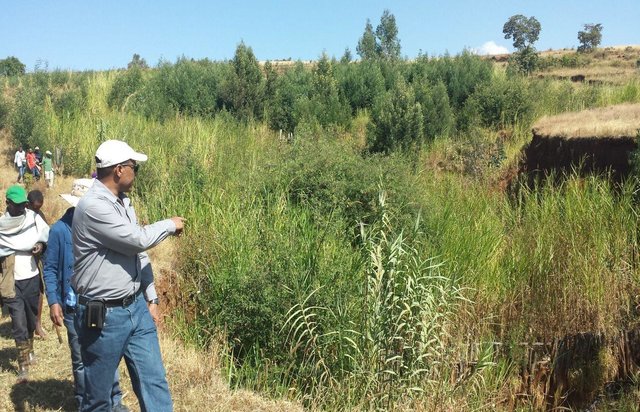
Gully erosion management [埃塞俄比亚]
Gully erosion management is the application of combination of practices to control excess or concentrated runoff generation in the gully upstream catchment area, divert excess runoff upstream of gully heads and control further development of gully using appropriate structural and vegetative measures in the head, bed and sides of the …
- 编制者: Gizaw Desta Gessesse

Rehabilitation of Degraded Lands ( Area closure) [埃塞俄比亚]
Closing the degraded land to let it to regenerate by excluding human and animal interference ans speed up the regeneration process by applying some SWC activities and undertake enrichment plantation.
- 编制者: Unknown User
2. SLM方法的描述
2.1 该方法的简要说明
Community mobilization for soil and water conservation work in a watershed planning unit is an approach for collective action by organizing all active labor forces living in the kebele/peasant association into development group of 20-30 members and further divide into 1:5 work force to implement construction of soil and water conservation measures, and implementing improved crop production technologies.
2.2 该方法的详细说明
该方法的详细说明:
Aims / objectives: The objective of this approach is to facilitate and motivate active participation of capable labor forces of the community for constructing soil and water conservation at watershed level for a period of 40-60 days starting from January every year
Methods: At preparation stage, identification of total labor forces and organizing into development groups (20-30 members) and 1:5 work force (6 members) and provision of awareness creation and training activities are carried out. At implementation stage, in reference to the plan, layout of the total physical structures are marked on the ground using line level survey tools. Based on established work norm, Development agents handover the quantity of work plan to all development groups. The development group leader again redistribute the same plan to 1:5 work force proportional to the number of active forces available in it. In principle, all active work forces equally share the work plan. Still, there is division of labor within team and between men and women. Men & women have different work norms. At completion of daily plan, each development group check the quality standard and development agents again take over the constructed structures from Development groups whenever structures meet quality standard as per design and layout. At completion of all watershed development work, development agents transferred the developed watershed to watershed committee in order to handle regulatory functions.
Monitoring and evaluation at implementation stage is clearly defined where 1:5 work team report daily physical work accomplished and number of members involved to the development group while Development group consolidate reports and pass to Development agent in the kebele and again the agent report to district agriculture office, then to zone agriculture office. Simultaneously, the 1:5 groups evaluate the work accomplished within a day and handover to development group which is then consolidated and passed to Development agents once in three days. The development agents summarized and presented to the Kebele command post (KCP) every week. The woreda experts together with District/Woreda command post member assigned in each cluster kebeles further consolidate the evaluation and report to woreda rural command post (WRDCP) and then the command post reflect on the evaluation and provide feed backs weekly to respective kebeles for follow up actio
Stages of implementation: 1. Planning: consulting community for selection of priority watershed, identify labor
2. Preparatory: mobilizing available labor force, hand tools, training,
3. Implementation: constructing planned physical structures
4. Monitoring and evaluation: checking quantity and quality of work done; supervision, field days
5. Sustainability: reinforcing physical structures with biological measures, formulating and enforcing bylaws, establishing user groups
Role of stakeholders: Land user: i) 1:5 work team: is responsible to implement the soil and water conservation work; ii) Development group: lead and evaluate the volume of work divided into the work teams within the group: iii) Watershed committee: is a legitimate body to develop watershed plan with the technical assistant from development agents and experts, as well as responsible for the management and equatable distribution of benefits obtained in the developed watershed.
Development agent: responsible for planning, technical support, training, supervision
Decision makers: The rural Command post, an adhoc formed at kebele, woreda, zone and region level and responsible for the supervision, control and oversight the overall watershed development activities. Sectors such as land use and administration, road authority, water resources, women and youths offices involved as member of command post to ensure integrity of sectors in the watershed development
Research: Research Institutes involved to introduce technologies, assess and evaluate performance of the approaches and technologies applied
NGOs: involved to support trainings, ad
2.3 该方法的照片
2.5 采用该方法的国家/地区/地点
国家:
埃塞俄比亚
区域/州/省:
Amhara region
有关地点的进一步说明:
BahirDar Zuria, Dembecha, Mecha, Yilmna Densa, DessieZuria
2.6 该方法的开始和终止日期
注明开始年份:
2010
2.7 方法的类型
- It is a government initiative reinstitutionalized since 2010
2.8 该方法的主要目的/目标
The Approach focused mainly on SLM with other activities (Plantation of biological conservation measures, application of improved crop and livestock production packages, agricultural implements)
The main objectives of community mobilization is to motivate farming community to take self responsibility to do soil conservation and involve them in public soil conservation work in order to address the problem of land degradation
The SLM Approach addressed the following problems: The main problems targeted to address by the approach are: growing challenges of land degradation and soil erosion; lack of commitment and ownership of soil conservation by farmers; lack of technical knowledge for implementing soil conservation
2.9 推动或妨碍实施本办法所适用的技术的条件
社会/文化/宗教规范和价值观
- 阻碍
Lack of agreement among farmers to do common runoff drainage structures.
Lack of commitment and motivation of land users to do soil conservation on their lands.
Free grazing challenge that lead to unsustainable soil conservation.
Treatment through the SLM Approach: The approach allows to follow watershed principles to integrate different soil conservation measures that safely drain excess runoff.
It also creates awareness and trust building measures and apply public labor to implement SLM technologies. Bylaws are formulated and enforcement mechanisms are arranged through watershed committees to control free grazing
财务资源和服务的可用性/可得性
- 阻碍
High labor cost to construct physical soil conservation measures;
High initial investment to rehabilitate gullies and plant seedling materials;
Lack of credit service for soil conservation investment.
Treatment through the SLM Approach: The government provide hand tools and supply seeds or seedlings to implement biological measures on bunds, gullies, and area closures
机构设置
- 阻碍
There are no local institutions/ community based organizations that capable to lead watershed implementation, manage developed watersheds, control and regulate free grazing and benefit sharing generated from communal land resources
Treatment through the SLM Approach: The approach attempts to establish legal body called watershed users association as a legal institution to administer developed watersheds and regulate the utilization of benefits on communal land resources.
Community based organizations such as development group and 1:5 work force are established for enhancing soil conservation implementations
法律框架(土地使用权、土地和水使用权)
- 阻碍
Restricted individual ownership or use right to do long term investment
Open access to communal land resources
Treatment through the SLM Approach: The approach enables to provide group use rights for the benefits such as fodder, hay and tree generated on communal land resources upon agreement through establishing user groups. It suggested to formalize the watershed users association at local level as a legal body to administer and regulate the developed watersheds, benefit sharing mechanisms and control of free grazing
The existing land ownership, land use rights / water rights moderately hindered the approach implementation There is no either individual or group entitlement of use rights for communal lands where communal grazing is taking place. Since there is culture of open grazing (animals allowed to graze freely) and pasture lands are communally used, this tradition affects the sustainability of the approach. Although there are community bylaws attempted to be enforced by watershed committees, farmers not yet fully practice cut and carry system of grazing.
了解SLM,获得技术支持
- 阻碍
Lack of technical knowledge of farmers and local level organizations
Treatment through the SLM Approach: The approach provides overall technical support in terms of awareness creation, initial training, on job service support and supervision. It provides practical training for surveyor farmers.
工作量、人力资源可用性
- 阻碍
There is high workload requirement to implement soil conservation
Treatment through the SLM Approach: The approach addresses the workload problem through mobilizing public labor
3. 相关利益相关者的参与和角色
3.1 该方法涉及的利益相关者及其职责
- 当地土地使用者/当地社区
Implementation of soil conservation work is fully handled by the community. The land users who contribute active labor forces engage in the implementation whereas all land users are involved in different activities depending on their capacity.
The land users are organized into development groups (20-30 members) and further into 1:5 teams (6 members). The role of men and women varies from location to location depending on the culture and social context. In some districts women have equal contribution, in others do less work than men. Sometimes, they have separate 1:5 team. Women have many roles and spend more time at home to prepare foods and look after children. They have less time to engage in the construction of soil conservation work. The approach suggests equal contribution and similar work norm for men and women and work together within the team. However, during implementation there is division of labor where men do the laborious activities and women assist them in bringing stones and maintaining the quality of structures. More over, there is less turn out of women than men. Roles of women at home are overlooked. The approach designed to engage all member of community in the public soil conservation work. Elders have role to play by taking care of animals and villages while active labor forces implement soil conservation. Youths and landless have involved with the expectation that they will have share of benefits from developed and protected communal resources. However, all are not equally engaged as those who depend on daily wage are not forced to spend the whole period in the soil conservation work
- SLM专家/农业顾问
They are involvde in the planning, support and supervision of the implementation, monitoring and evaluating the implementation
- 教师/学龄儿童/学生
They are not actively involved but participate during the starting ceremony
- 地方政府
The local government is fully involved in the planning process and in the implementation by providing technical support, monitoring, and supervision
- 国家政府(规划者、决策者)
The government is responsible for strategic planning, supervision and control of the implementation, and monitoring and evaluation. They do the strategic plan at higher level.
They are involved in the supervision and monitoring and evaluation as member of the command post
3.2 当地土地使用者/当地社区参与该方法的不同阶段
| 当地土地使用者/当地社区的参与 | 指定参与人员并描述活动 | |
|---|---|---|
| 启动/动机 | 被动 | The primary initiation is coming from the government to combat land degradation issue in the highlands of the country. The land users have little involvement in the initiation however kebele leaders are involved in the initial phases together with the decision makers at district level. |
| 计划 | 被动 | The planning is from top to down. The tentative plan based on the Growth and Transformation Plan and previous achievements trickled down to region, zone and districts. The lower level check the plan within watershed contexts and submit to higher level planning units. Finally, the higher level planners/specialists develop more ambitious technology plan and later land users are consulted only for the implementation. However, land users are involved in selection of the watershed to be developped. |
| 实施 | 互动 | Land users are actively involved to construct or implement planned soil conservation works through their organizational setup (development groups and 1:5 work force). They do implementation with technical support and guidance from the development agents and agricultural experts. On the other hand, the decision makers through the rural command post supervise and monitor weekly implementation and send feedback for immediate actions. |
| 监测/评估 | 互动 | Land users particularly those who are leaders of the development group and the members of the watershed committee are involved in the day to day supervision, monitoring and quality control of the implementation together with development agents. The main actors for monitoring and evaluation are the technical experts at district, zonal and regional levels as well as the command post members at kebele, district, zonal and regional levels |
| Research | 互动 | Land users are involved in research problem identification, participatory technology selection process, and scale up of research technologies. |
3.3 流程图(如可用)
具体说明:
The organizational chart depicts main actors involved in planning, implementation and supervision as well as monitoring and evaluation stages at different level of the government structure. The agriculture sector is the lead responsible sector to plan and implement the approach with technical and financial support from research, NGOs and projects. The approach involves different related sectors through the setup of Command Post in order to support the community organization and mobilization and facilitate integrity and synergy across different rural sectoral activities in watershed development. The main implementing bodies are the district agriculture office through the development agents, local community organizations at Kebele level with direct support, guidance and supervision by the district office of agriculture.
作者:
Sketched by the main contributing author (WLRC, P.O.Box 8707, Addis Abeba, Ethiopia)
3.4 有关SLM技术选择的决策
是否就技术的选择做出了决定?:
- Mainly by SLM specialists
解释:
The planning of SLM technology made by experts and later land users are consulted through public meeting. The experts select technologies by doing analysis of the soil, land use and slope conditions of the watersheds. There is no individual based consultation or the land users do not participate in the choice of technologies.
Decisions on the method of implementing the SLM Technology were made by By SLM specialists . The land users are asked to contribute their labor for implementing the technology through their local organizations (kebele adminstration, development group, 1:5 work force). They do not decide on the method of implementation of technologies.
4. 技术支持、能力建设和知识管理
4.1 能力建设/培训
是否为土地使用者/其他利益相关者提供培训?:
是
明确受训人员:
- 土地使用者
- 现场工作人员/顾问
- decision makers at district and zonal levels
培训形式:
- 在职
- 农民对农民
- 示范区域
- 公开会议
- 课程
涵盖的主题:
Land degradation problems and consequences, natural resources conservation and community mobilization for leaders of development groups and kebele leaders. The training for farmer surveyors is focused on how to measure slope, vertical interval, aligning contours for layout of soil conservation structures and waterways. The experts at different levels and field staffs get an in depth training about the selection, layout and design of soil conservation structures.
4.2 咨询服务
土地使用者有权使用咨询服务吗?:
是
指明是否提供了咨询服务:
- 在固定中心
说明/注释:
Name of method used for advisory service: Participatory Demonstration and Training System (PADETS); Key elements: Training and awareness creation, Demonstrations in the Farmer Training Centers (FTC) and experience visits, On the job training; The method give high emphasis to training and to some extent practical demonstrations complemented with experience sharing visits. The participation of land users is not active enough, it is rather of consultative nature.
Advisory service is inadequate to ensure the continuation of land conservation activities; It needs strongefforts to build the capacity of the community to empower them, and establish a powerful system to have continuous supply of improved agricultural technologies and value chain system that help to improve productivity per unit of land. Further more, if the newly created Watershed Users Associations function well, it would be adequate to regulate and sustain land conservation and watershed management using a community mobilization approach.
4.3 机构强化(组织发展)
是否通过这种方法建立或加强了机构?:
- 是,适度
具体说明机构的强化或建立程度:
- 本地
具体说明支持类型:
- 能力建设/培训
提供进一步细节:
The local institutions like the watershed committee/watershed users association, Farmer Training Centers and Farmer-Research-Extension-Group are supported by training and experience sharing visits.
4.4 监测和评估
监测和评估是该方法的一部分吗?:
是
注释:
bio-physical aspects were ad hoc monitored by project staff, government, land users through observations; indicators: Area coverage, design/layout quality, land cover
bio-physical aspects were regular monitored by project staff through measurements; indicators: Growth, biomass/productivity, regeneration
technical aspects were regular monitored by project staff, government, land users through observations; indicators: Spacing, integrity of structures
socio-cultural aspects were ad hoc monitored by project staff through observations; indicators: Conflict, user groups, benefit sharing, perceptions
economic / production aspects were regular monitored by project staff through measurements; indicators: Weigth gain of animals, productivity of crops, income and livelihood
area treated aspects were ad hoc monitored by project staff, government, land users through observations; indicators: Area covered, type and quality of technology
area treated aspects were regular monitored by project staff, government through measurements; indicators: Area covered, type of technology
no. of land users involved aspects were regular monitored by project staff, government, land users through measurements; indicators: daily work force/attendants, gender
management of Approach aspects were regular monitored by project staff, government, land users through observations; indicators: Role of actors, encountered problems, actions taken
There were several changes in the Approach as a result of monitoring and evaluation: Monitoring and evaluation leads to changes in order to ensure effectiveness. It is flexible to modify some of the elements of the approach although the core steps or procedures are not changed. Limitations are observed on the technical and leadership capacities and passive participation of land users. The main role of the monitoring and evaluation is thus to identify the limitations and problems encountered so that immediate corrections can be made such as changing the ad hoc leadership, provide on the job training, motivating passive ones or sanction those who violate bylaws.
There were several changes in the Technology as a result of monitoring and evaluation: Since the planning is not adequate enough to capture the real biophysical conditions and socio-cultural settings, the selection of SLM technologies may fail to fit selected watersheds. With the help of specialists who are monitoring and supporting on the job services, the SLM technologies are subjected to change. Close interactions and discussions may change the SLM technology plan.
4.5 研究
研究是该方法的一部分吗?
是
明确话题:
- 生态学
- 技术
提供进一步的细节,并指出是谁做的研究:
Research is part of the approach. The SLM technologies are complemented with improved package of agricultural practices like improved crop and horticultural varieties, forage species, tree species, agricultural implements through demonstrations and scale up activities. Monitoring and evaluation of ecological and socio-economic performances and impacts of the SLM technologies and agricultural practices are the roles of research.
Research was carried out on-farm
5. 融资和外部物质支持
5.1 该方法中SLM组成部分的年度预算
注释(例如主要的资助来源/主要捐助者):
Approach costs were met by the following donors: local government (district, county, municipality, village etc) (The government contributes to material, technical and supervision support): 36.0%; local community / land user(s) (All the labor requirement meet by the community): 64.0%
5.2 为土地使用者提供财政/物质支援
土地使用者是否获得实施该技术的财政/物质支持?:
是
如果是,请具体说明支持的类型、条件和提供者:
The inputs like seedlings for biological measures planted on structural soil conservation measures, gullies and degraded lands, and gabions for constructing gully check dams are provided by the government
5.3 对特定投入的补贴(包括劳动力)
- 设备
| 具体说明哪些投入得到了补贴 | 程度如何 | 对补贴做出具体说明 |
|---|---|---|
| 工具 | 部分融资 | hand tools for construction |
- 农业
| 具体说明哪些投入得到了补贴 | 程度如何 | 对补贴做出具体说明 |
|---|---|---|
| 充分融资 | ||
| Seedlings | 充分融资 | Seedlings (trees, forage grasses, shrubs, fruits) |
- 建筑
| 具体说明哪些投入得到了补贴 | 程度如何 | 对补贴做出具体说明 |
|---|---|---|
| Gabions | 充分融资 | For check dams |
注释:
The land users contribute voluntary labor for the construction of SLM measures through their local organizations.
5.4 信用
是否根据SLM活动的方法给予信用值?:
否
6. 影响分析和结论性陈述
6.1 方法的影响
该方法是否帮助土地使用者实施和维护SLM技术?:
- 否
- 是,很少
- 是,中等
- 是,支持力度很大
The approach first of all help to develop integrated natural resources management in order to mitigate on site soil erosion and land degradation and improve soil moisture and biomass (crop and forage) productivity. It also helps to increase level of awareness of land users to control free grazing, protect communal resources and share benefits out of it. It also gradually enhances ecosystem services by increasing the amount and duration of flow of streams
该方法是否有助于社会和经济弱势群体?:
- 否
- 是,很少
- 是,中等
- 是,支持力度很大
Interventions like production of improved energy saving stoves, production of improved breeds of poultry and sheep, and apiary targeted to improve the livelihood of specifically women and youths who are landless. Youths are organized into groups to provide services such as production of energy saving stoves and operation of threshing and tillage activities
该方法是否改善了阻碍SLM技术实施的土地使用权/用户权问题?:
- 否
- 是,很少
- 是,中等
- 是,支持力度很大
For example, forage development intervention is the main component of SLM technologies. Thus, the approach helps to reduce the problem of free grazing by implementing forage development interventions on backyards, area closures, gullies, bunds and intensive forage production. In addition, community agreed bylaws are designed although there is still inadequacy in enforcing bylaws.
Did other land users / projects adopt the Approach?
- 否
- 是,很少
- 是,中等
- 是,支持力度很大
The approach practiced uniformly throughout the districts by the government although some districts have one year experience ahead. In fact there are differences in efficiency and effectiveness across districts.
Did the Approach lead to improved livelihoods / human well-being?
- 否
- 是,很少
- 是,中等
- 是,支持力度很大
Using the approach, some land users who were involved in alternative livelihood options such as sheep rearing, apiary, fattening, and poultry production as well those who took part in the production of crops using improved varieties of potato, teff and wheat generate income and improve their livelihoods.
Did the Approach help to alleviate poverty?
- 否
- 是,很少
- 是,中等
- 是,支持力度很大
Through increased productivity, creating employment and income generating activities the approach help to alleviate poverty in the medium and long term periods.
6.2 土地使用者实施SLM的主要动机
- 增加生产
Increase productivity of their land
- 减少工作量
Land users desire to implement SLM with external support to reduce workload by using comm. labor
- 支付/补贴
Gain in kind support in the form of seeds and seedlings, and agricultural technologies
- 规章制度(罚款)/执行
Maximize benefits through equitable share of resources from area closures and reduce conflicts
- well-being and livelihoods improvement
Improve livelihood by introducing improved crop and livestock technologies, and alternative options
6.3 方法活动的可持续性
土地使用者能否维持通过该方法实施的措施(无外部支持的情况下)?:
- 是
若是,请说明如何维持:
Experience from last three years implementation of the approach indicates that land users can moderately sustain approach activities without support. However, this can be maximized if further technical support is given for land users to continue the curent motivation and commitment; facilitate group actions through well functioning organizational setups by strengthening watershed users' associations; and empowering land users to do soil conservation by their own.
6.4 该方法的长处/优点
| 土地使用者眼中的长处/优势/机会 |
|---|
|
It supports forage and horticulture seedling material. Introduce benefit sharing in the form of forage legumes and grasses from area closures and gullies for those who have no access to common resources. Introduce improved agricultural production technologies like varieties, breeds, implements for plowing, harvesting and threshing. Change waste lands into productive land. (How to sustain/ enhance this strength: The land users has to be motivated to establish private nursery to meet their own plantation demand. Strength scale up of technologies to wider areas. Establish farmer to farmer seed/ technology exchange. Establish and strengthen mechanization users groups or service providers. Enhance homestead development with alternative livelihood options. Change waste lands and gullies into productive land by producing fruits and timbers. ) |
| 编制者或其他关键资源人员认为的长处/优势/机会 |
|---|
|
The approach help to further strengthen those innovative farmers and make aware of natural resources conservation. Introduce use rights on common resources after watershed development. Start to develop bylaws to control free grazing. Establish legal watershed institution - watershed users' association. Treats more degraded and erosion sensitive areas in short period. It enhances awareness and participation of political leaders/decision makers and land users on land degradation and its consequences. Enhance on-site and to some extent off-site ecological services. (How to sustain/ enhance this strength: Build the capacity of land users. Establish strong watershed organizations and enhance its capacity to regulate and enforce rules. Establish strong planning and regulatory functions of the government. ) |
6.5 该方法的弱点/缺点以及克服它们的方法
| 土地使用者认为的弱点/缺点/风险 | 如何克服它们? |
|---|---|
|
Overlapping of different agricultural activities (threshing and irrigation) during the period of SWC public work which limit land users' participation. Limitation to implement cut and carry system of grazing without intensive forage development interventions by all land users. |
Context specific public SWC work need to be agreed by land users. Further discussion with community and possible options has to be taken place to implement cut and carry system of grazing in watersheds. |
| 编制者或其他关键资源人员认为的弱点/缺点/风险 | 如何克服它们? |
|---|---|
|
Less involvement of land users in decision making at different stages. Technology selection process has to be supported with realistic local data related to biophysical and social conditions of watersheds. Lack strong performance/impact monitoring and evaluation of the developed watersheds after implementation. Inadequate support of watershed committee by higher level units (like courts) to enforce agreed bylaws. Inadequate economic interventions as compared to biophysical interventions. |
Mechanisms like Watershed associations need to be strengthened to increase the level of participation of land users in decision making during planning. Watershed assessment data has to be used for improved planning. Establish an evaluation guideline to evaluate performance. The newly established watershed organization or association has to be considered as a legitimate body to administer and regulate the watersheds. The support of research to introduce technologies has to be strengthened and started equally with the biophysical interventions during watershed development stages. |
7. 参考和链接
7.1 方法/信息来源
- 实地考察、实地调查
- 与土地使用者的访谈
7.2 参考可用出版物
标题、作者、年份、ISBN:
Abera Wondafrash, Belayneh Ayele, Getachew Engidayehu, Girmachew Siraw, Gizaw Desta, Leulsegged Kasa, Mesfin Legesse, Selamyihun Kidanu, Wale Jemberu, Yared Zegeye, Zerihun Nigussie (2012).ASSESSMENT OF NATURAL RESOURCE MANAGEMENT WORKS THROUGH PUBLIC MOBILIZATION IN AMHARA NATIONAL REGIONAL STATE, ETHIOPIA
可以从哪里获得?成本如何?
Unpublished report
标题、作者、年份、ISBN:
Annual reports of BOA in Amhara (unpublished)
链接和模块
全部展开 全部收起链接

Vegetated graded soil bund [埃塞俄比亚]
Vegetated graded soil bund is a soil conservation practice meant for cultivated lands and constructed by excavating graded channel on upper side and develop embankment on lower side which is planted with grass or shrub species in order to control soil erosion and drain excess runoff implemented through community mobilization.
- 编制者: Gizaw Desta Gessesse

Gully erosion management [埃塞俄比亚]
Gully erosion management is the application of combination of practices to control excess or concentrated runoff generation in the gully upstream catchment area, divert excess runoff upstream of gully heads and control further development of gully using appropriate structural and vegetative measures in the head, bed and sides of the …
- 编制者: Gizaw Desta Gessesse

Rehabilitation of Degraded Lands ( Area closure) [埃塞俄比亚]
Closing the degraded land to let it to regenerate by excluding human and animal interference ans speed up the regeneration process by applying some SWC activities and undertake enrichment plantation.
- 编制者: Unknown User
模块
无模块


